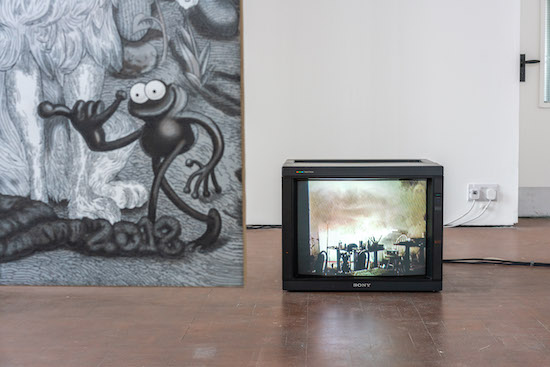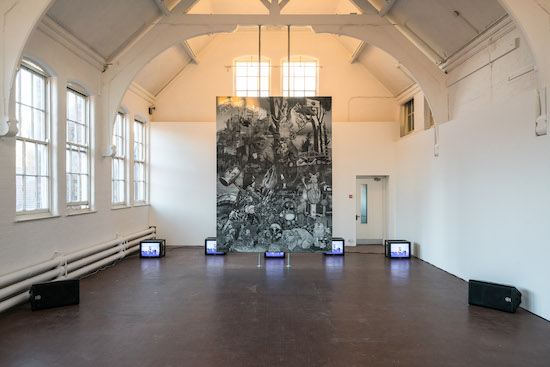From the outside, Primary is unassuming. It’s in a residential area, you don’t come straight off of the street and into a white room, it gives off an inclusive impression. It feels like a community space, there’s an organic bakery on the bottom floor – It reminds me of German anarchist squats that have long since become social centres. It’s a welcoming space, an interesting one in which to view the new solo exhibition PII by Parker Ito, an artist whose work and public presence have been a subject of great contention in recent years.
Approaching the gallery space up a set of stairs, I can hear muffled music. It sounds like a band is practicing somewhere in the building – something that felt unsurprising. The exhibition is not exactly what I was expecting from Ito. The work, in its entirety, comprises an audio loop, five screens playing the same video and a large painting – all set towards the back of the room. The approach is something similar to an altar piece. With one side of the room entirely bare, the work confronts you on entry.
The painting is suspended between the floor and ceiling on thick metal piping, something that makes the viewer very aware of how secure it is in the space. You’re able to walk behind it, the bare linen left on the sides and the primer leaking through the back making it entirely clear that what you’re looking at is a painting.
The underpainting is oil, with digital drawings screen printed on top in thick black ink – it all feels very deliberate. I suppose art is maybe supposed to be deliberate, something which has been decided upon and created but Ito is an artist who has faced accusations of flippancy from critics. PII (and P, it’s predecessor shown concurrently at Team gallery’s New York and Venice Beach locations over the summer) feel like a reaction to this. They feel almost like an artist asserting themselves as an artist, free from the accoutrement of previous works (like 2014’s i can’t fuck u tonight i’m reading proust) the P series feels like an artist intent on shedding the discussions that have surrounded their work for nearly half a decade. Parker Ito is not (and in my opinion, has never been) a flippant artist, with PII, he is taking back his agency – reigning in the viewer.
This is apparent in the curation, the televisions set back behind the painting, obscured. In order to investigate the content of each screen, the viewer is led behind the painting. In order to get to them, first you must get very close to the painting. The weight of the stretcher becomes apparent, the texture of the linen and the application of pigment to surface. The painting overwhelms the room, insisting on its presence, insisting on its validity. Set towards the back, the density of the work fills the room entirely. Even the positioning of the audiovisual elements of the show speaks to the weight of the painting, they sit on the floor in a semi circle, the painting set forward raised above them.

The video itself is a loop of around ten minutes, aesthetically resembling home recordings. Snippets of traffic, the Capitol Records building and Smart Water bottle coming in and out of focus. The scattered references to pop culture, the allusion to consumer identities and lived experience that we have come to expect of Ito’s work are still present here – just re-presented, calculated and reformed. The audio piece is the same, a loop of snippets from music, saturated and lofi – playing very slightly too loud to be comfortable, a reference to distraction or the dissonant inspirations at play in Ito’s work. There are likely references within these two aspects of PII that I’ve missed but this aspect of Ito’s work has always been an important one. Cultural impressions are often taken through an individual lens, no single viewer is likely to parse every detail of any single work.
The large painting at the centre of PII is a clear example of this. The images silkscreened onto the painting are a litany of doodles, cultural markers, characters and logos; thrown into narrative through their graphic representation. I found myself seeking ballast, looking for something with which to begin deciphering the code – some idol that I could understand and interpret.
In Ito’s work, this has always been a fool’s errand. Like a finger trap, the harder you pull, the harder it is to free yourself. He’s an artist who presents work through a lens. As viewers, it seems almost pointless to understand this lens – we come equipped with our own. Whilst a more minimal showing than some of his earlier works, PII has retained the thing that most attracted me to Ito’s work in the first place. It doesn’t seek to provide answers for the viewer, maybe clues, maybe signposts but never a map. “Welcome To Hollywood” is written in the top corner of the painting, the Capitol Records building present in both, Hollywood is a synonym – Ito is simplifying his world for us, putting it into terms that we can understand. Gone are the aliases, the saturation, in PII, he provides the viewer with the experience that he has been perennially asked for but does so through his own impenetrable critical lexicon.
Parker Ito, PII, is at Primary, Nottingham until 17 November


